Category 4 Hurricane Fiona bearing down on Bermuda before pummeling Atlantic Canada
Hurricane Fiona is making its closest approach to Bermuda with hurricane-fore winds and dangerous surf expected throughout Friday before the storm system slams into Atlantic Canada over the weekend.
The threat of the powerful storm has prompted Hurricane Watches and Tropical Storm Watches to be issued for hundreds of miles of coastline from Nova Scotia to Newfoundland.
Fiona remains a Category 4 hurricane in the western Atlantic with maximum sustained winds around 130 mph, an intensity it first achieved early Wednesday, which makes Fiona the Atlantic's strongest hurricane of the 2022 season so far.
Any hurricane that is rated Category 3, 4 or 5 on the Saffir-Simpson Hurricane Wind Scale is classified as a major hurricane.
Where is Hurricane Fiona?
As of Thursday evening, Hurricane Fiona was centered less than 280 miles west-southwest of Bermuda and 1,000 miles south-southwest of Nova Scotia. The Category 4 storm moving north-northeastward at 20 mph, a track which will take the major hurricane to the west of Bermuda and then into the Canadian Maritimes.
HOW TO WATCH FOX WEATHER ON TV
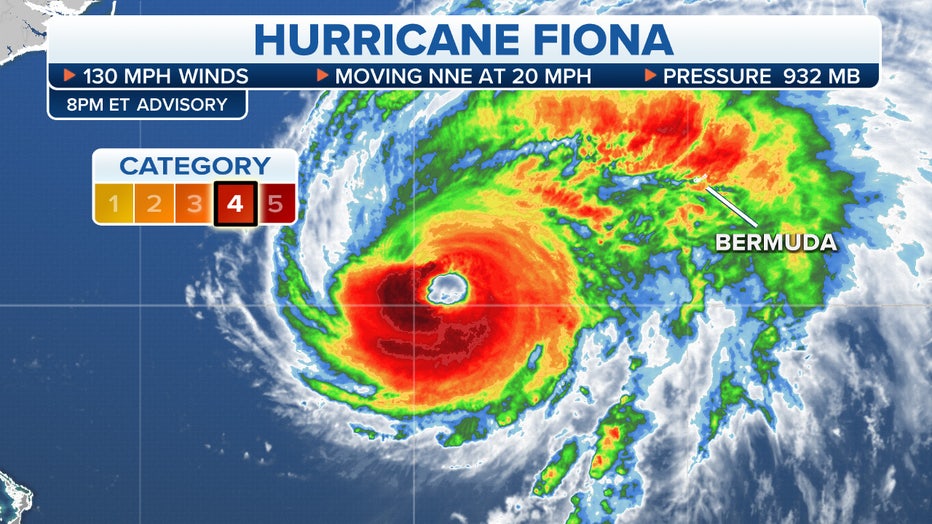
Tracking Hurricane Fiona. (FOX Weather)
Where are watches and warnings in effect?
Bermuda is under a Hurricane Warning.
A Hurricane Warning means sustained winds of 74 mph or higher are expected within the warning area. These high winds are likely to be accompanied by storm surge, coastal flooding and/or river flooding.
WHAT TO DO WHEN HURRICANE OR TROPICAL STORM WATCHES AND WARNINGS ARE ISSUED FOR YOUR TOWN
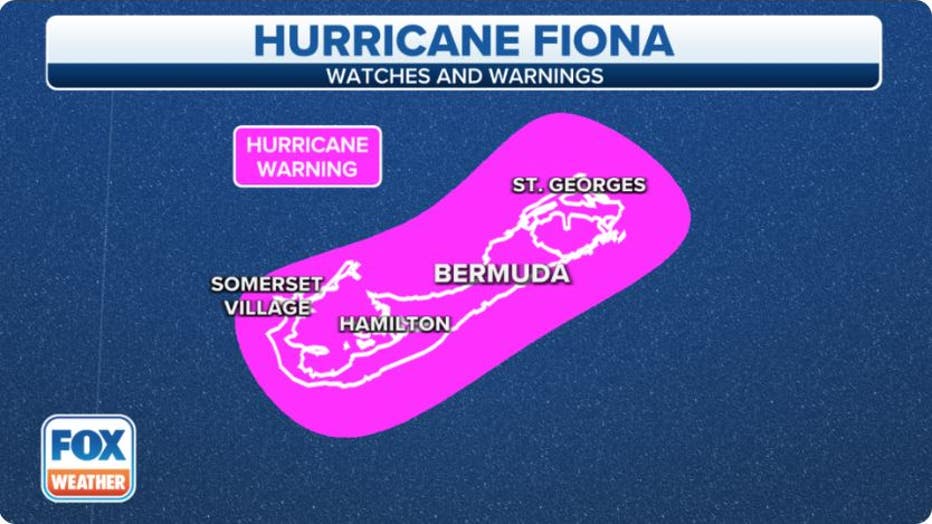
A Hurricane Warning is in effect for Bermuda. (FOX Weather)
Additionally, the Canadian Hurricane Centre issued a Hurricane Watch across the Canadian Maritimes. Nova Scotia from Hubbards to Brule, as well as for Prince Edward Island, Isle-de-la-Madeleine and along the coast of Newfoundland from Parson’s Pond to Indian Harbour.
A Hurricane Watch means sustained winds of 74 mph or higher are possible within the watch area and is typically issued 48 hours before the anticipated first occurrence of tropical-storm-force winds (39-plus mph).
The Canadian Hurricane Centre has also issued a Tropical Storm Watch from St. Andrews, New Brunswick, to west of Hubbards, Nova Scotia, and from west of Brule, Nova Scotia, to Cap Madeleine, Quebec.
A Tropical Storm Watch has also been issued for Anticosti Island, and from Sheldrake, Quebec to north of Parson's Pond, Newfoundland. Tropical Storm Watches are also in effect from West Bay, Labrador, to Hare Bay, Newfoundland, and from Indian Harbour to St. Lawrence, Newfoundland.
A Tropical Storm Watch means sustained winds of 39 mph or higher are possible within the watch area, generally within 48 hours.
Note that these watches do not include the Avalon and Bonavista peninsulas.
DRONE VIDEO SHOWS 50-FOOT WAVES AND DESTRUCTIVE WINDS IN THE HEART OF HURRICANE FIONA
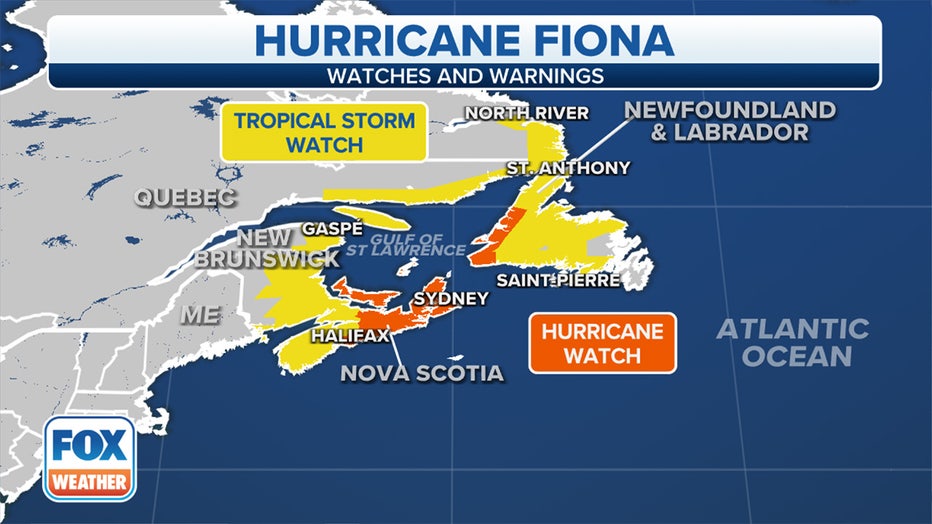
Hurricane and Tropical Storm Watches are in effect for parts of Atlantic Canada. (FOX Weather)
What are the expected impacts of Hurricane Fiona in Bermuda and Atlantic Canada?
According to the FOX Forecast Center, the peak impacts in Bermuda are expected through Friday morning as the center of Hurricane Fiona passes to the west of the archipelago.
Those impacts in Bermuda will include hurricane-force winds (74-plus mph) and 2 to 4 inches of rain, as well as large, pounding surf and storm surge.
Fiona is then forecast to continue north or north-northeastward just to the west of Bermuda overnight and slam into Nova Scotia this weekend as a powerful post-tropical cyclone.
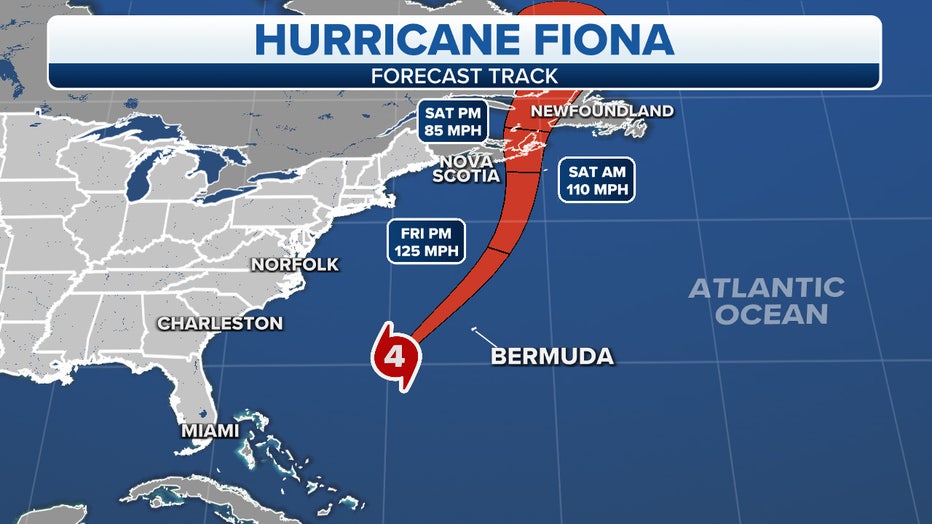
The projected path and intensity of Hurricane Fiona. (FOX Weather)
The FOX Forecast Center warns that parts of Newfoundland, Nova Scotia and Prince Edward Island will have threats of damaging winds, flooding rainfall and storm surge as Fiona crashes ashore in Atlantic Canada.
"Hurricane Fiona has the potential to be a landmark weather event in Eastern Canada this weekend, and we encourage the public to continue to monitor the forecasts regularly," the Canadian Hurricane Centre wrote on Twitter Thursday morning.
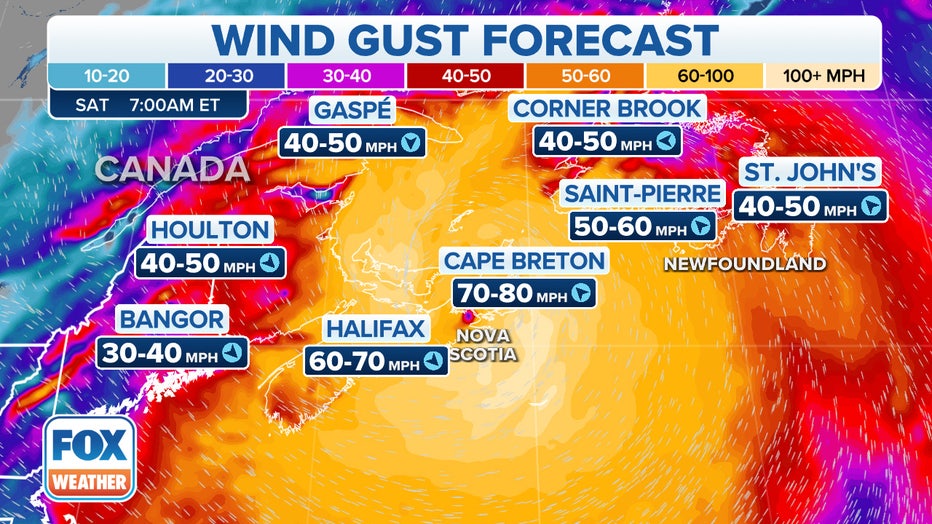
Wind gust forecast in Atlantic Canada. (FOX Weather)
Widespread power outages, downed trees and structural damage are all potential impacts of Fiona in Atlantic Canada, regardless of whether it has transitioned to a post-tropical cyclone or if it's still a hurricane.
Between 3 and 6 inches of rain, with localized amounts up to 10 inches, is predicted across Nova Scotia, Prince Edward Island and western Newfoundland. This rainfall could result in areas of flooding, some of which might be significant.
Two to 5 inches of rain is forecast for eastern Quebec, while 1 to 3 inches is expected in eastern New Brunswick and eastern Newfoundland.

Rainfall forecast in Atlantic Canada. (FOX Weather)
Fiona could be one of Canada's strongest storms on record
Computer forecast models indicate Fiona has the potential to challenge September low-pressure records in portions of Nova Scotia on Saturday, according to David Roth, a senior branch forecaster at NOAA's Weather Prediction Center.
It's not out of the question that Fiona's central pressure could even approach Canada's all-time lowest pressure, which currently stands at 940.2 millibars set on Jan. 20, 1977, in St. Anthony, Newfoundland.
In fact, according to Roth, most of the country's low-pressure records were set during intense winter storms rather than tropical or post-tropical cyclones.
But Atlantic Canada is also no stranger to hurricanes or their remnants.
Since 1951, the Canadian Hurricane Centre said the country has seen around two-dozen hurricanes or post-tropical cyclones that have made landfall along its Atlantic coast.
HURRICANE FIONA'S POTENTIAL PATH TO CANADA IS NOT COUNTRY'S FIRST HURRICANE IMPACT
The names of recent tropical cyclones to impact the expansive coastline include Larry in 2021 and both Teddy and Isaias in 2020.
Hurricane Juan of 2003 is considered to be the most destructive in recent history. The Category 2 hurricane made landfall with winds of around 100 mph on Sept. 29.
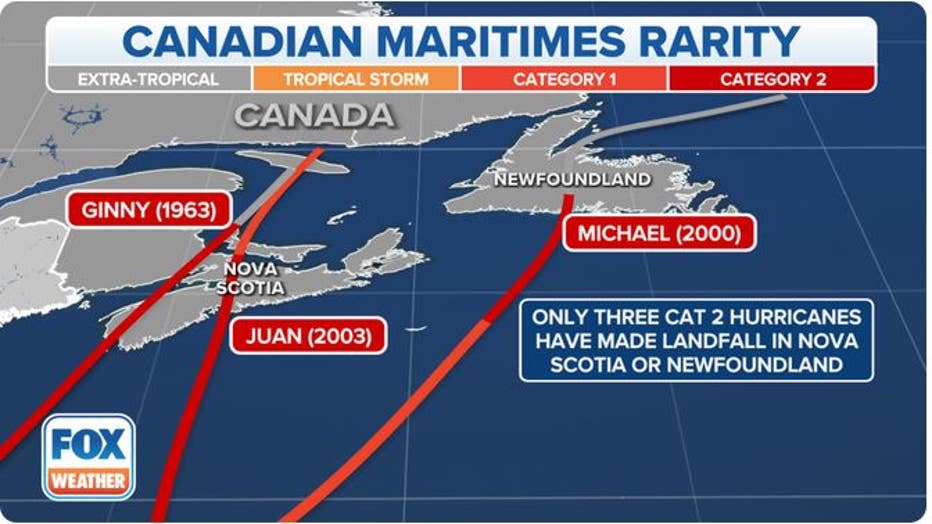
Recent tropical strikes in Canada. (FOX Weather)
Juan's winds were strong enough to knock over trees, trigger thousands of power outages, damage homes and sink boats.
Some of the hardest-hit regions were Nova Scotia and Prince Edward Island.
What are the impacts to the US East Coast?
Even though Hurricane Fiona will stay hundreds of miles off the U.S. East Coast, its indirect impacts will be felt along the Atlantic beaches from Florida to Maine.
Swells from the Category 4 hurricane will continue to spread westward toward the Eastern Seaboard over the next couple of days.
The rough waters will increase the risk of life-threatening rip currents along beaches, and lifeguards caution less-skilled swimmers to never venture into the rough waters.
WATER FROM HURRICANES, TROPICAL STORMS KILLS MORE IN U.S. THAN WIND
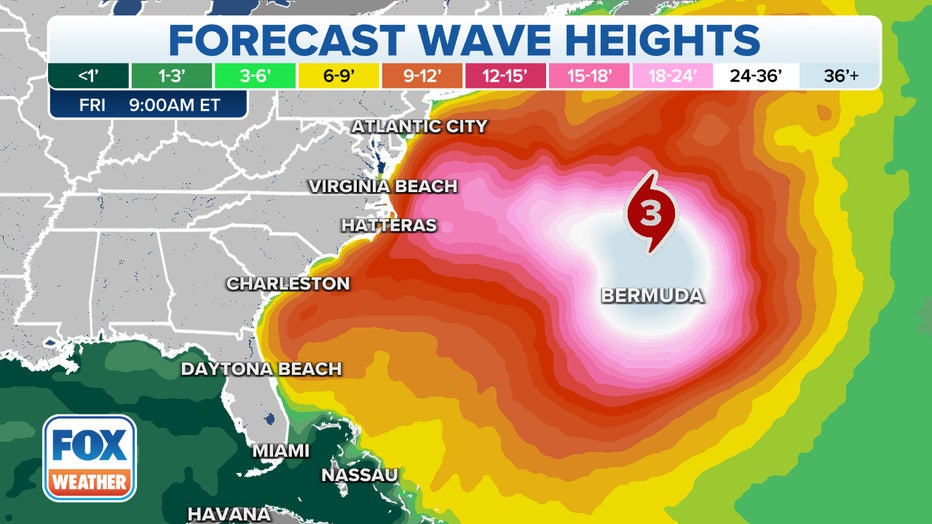
Forecast wave heights off the U.S. East Coast. (FOX Weather)
Hurricane Fiona's impacts in the Caribbean
Fiona made two landfalls as a Category 1 hurricane, the first one Sunday afternoon along the extreme southwestern coast of Puerto Rico and the second one early Monday morning in the eastern Dominican Republic.
In Puerto Rico, the city of Ponce clocked a 103-mph wind gust, while in the Dominican Republic, a gust of 98 mph was recorded in Samana at El Catey International Airport. The high winds plunged all of Puerto Rico into a blackout on Sunday as catastrophic flooding unfolded across the U.S. territory.
On Wednesday, President Joe Biden declared Puerto Rico a major disaster area to help with recovery efforts.
DEATH TOLL RISES TO AT LEAST 8 AFTER POWERFUL HURRICANE FIONA LASHES CARIBBEAN
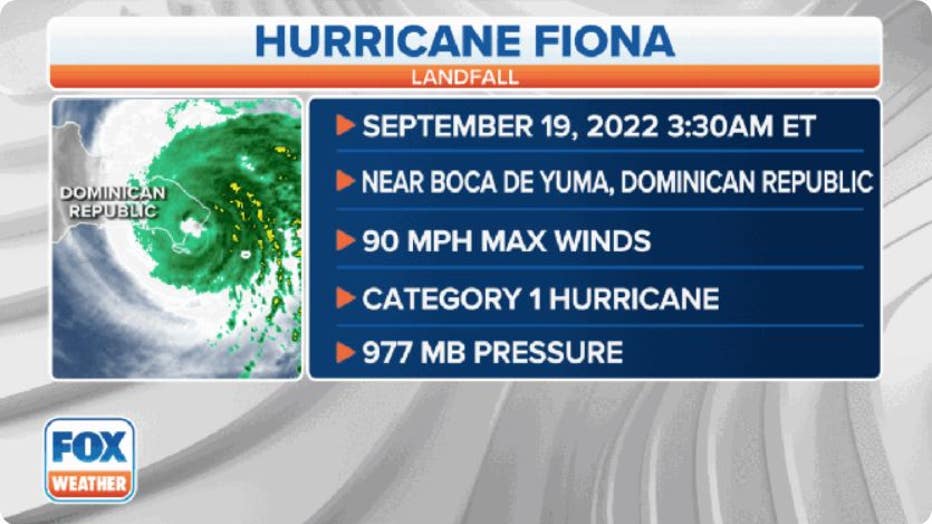
Hurricane Fiona made its first landfall in southwestern Puerto Rico on Sunday, Sept. 18, followed by a second landfall in the eastern Dominican Republic on Monday, Sept. 19. (FOX Weather)
Hurricane Fiona battered the Turks and Caicos on Tuesday as high winds and heavy rain spread across the islands after the hurricane had already turned deadly in Puerto Rico and the Dominican Republic.
FEROCIOUS HURRICANE FIONA BATTERS TURKS AND CAICOS ISLANDS WITH STRONG WINDS, TORRENTIAL RAIN
Elsewhere in the Atlantic
Four other systems are also being tracked in the Atlantic right now, including Tropical Storm Gaston in the central Atlantic, Invest 98L off the coast of South America and two other tropical disturbances to the west of Africa.
ATLANTIC HURRICANE SEASON REACHES CLIMATOLOGICAL PEAK SEPT. 10
An overview of the tropics in the Atlantic Basin. (FOX Weather)

